
 School of Drums
School of Drums
Don't miss this
goldmine of free drum set lessons w/video. If you do not yet own a drum set just keep practicing the way you have been. You will appreciate this lesson a
little more when you finally get your drums. This lesson is for those students with horrible sounding drums. I contend that even the cheapest drums may be tuned to your satisfaction. The secret is in knowing how to get the
sound that you want. It needs to be noted that there isn't a specific standard-pitch for tuning our drums. We tune to our ear.
Inside our 'mind's ear' we must first imagine, exactly how we want the drum to sound; then we set about pulling that exact
tone from the drum. No one should dictate to the drummer what their drums should sound like. We all tune to our
own personal specifics. What pleases me may not please you at all . . . and vice versa. When tuning a drumset, we must know what tones we are looking for and we must learn how to pull those specific tones from each drum.
I have assembled the following pointers to help with that one objective in mind. Look closely at your snare drum and try to decide exactly what factors most effect the tonal quality. Notice the 'square
headed screws' around the top and bottom rims of the Drum. We call these ‘tension rods' or 'tension screws'. We may tighten or loosen these
screws with a tool called a 'drum key. A drum key can be purchased at any music store for a dollar or two. Adjustments to the
tension rods with a drum key will effect the tension on the Drumhead. A tight drumhead will produce more bounce for the drumsticks and a higher pitch, whereas less tension on the head will
produce the opposite. A little experimentation will help you decide the exact tension you personally prefer. You will be tuning your drums to
your own specifics and personal preferences. Be cautious when adjusting the tension-screws around any drumhead so as not to warp either the
drumhead or the rim. Do not over-tighten one screw while leaving another very loose.
It is best to tighten the screws in a diagonal criss-cross pattern around the head. Cautiously
turn each tension-screw an equal number of turns until you have achieved the desired tension. Doing so
will help seat the drum-head evenly. Now turn your snare drum over and look at the strands of wire underneath. We call these (plastic or metal)
wires, ‘snares'. The ‘snares' produce the ‘snap' sound and give the ‘snare' drum its name. Without
these ‘snares' your drum would sound like a tom-tom. The snare wires are usually connected on the bottom
sides of the drum with a screw apparatus and usually a flip lever apparatus. The flip lever on most drums is usually
designed to release the snares quickly, so that a tom effect can also be quickly achieved as a tonal option. A flip-lever and/or screw-apparatus on the side of the drum called the ‘strainer' may
be tightened to place the desired amount of tension on the snares (wires) beneath the drum. This will require
some experimentation before you will discover the exact snap or (looser resonant) tone you prefer. After tuning
both heads and adjusting the Strainer you may find that your Snare Drum still emits an
undesirable 'ring' or 'overtone' when struck a glancing blow with a drumstick. Too much
vibration in the outer perimeters of the 'batter' (top) head will often cause this overtone, and some type of
muffling device may be necessary. A drum muffler is simply a screw device that places
a felt pad against the batter head from inside the drum. The muffler is usually equipped with
a flip lever or turn screw that allows for easy external adjustment. Almost all older snare drums came
from the factory with internal mufflers installed. In recent years the foreign drum set manufacturers have
stopped putting them in the newer drums. (They need to know that those old internal-mufflers are missed.) The internal mufflers served an important
function that is now being neglected. Almost any music store will install the older style internal mufflers for
twenty or thirty dollars (per drum). Again it is up to you to decide whether you like your
drum with or without a muffler. Check out the individual accessory
courses (products) in the right column and bottom of this page! You can get ALL of them free, with a simple donation
of $45.00 or more. Those courses will show you how to put the $45 right back into your
own pocket, A THOUSAND TIMES! If you are still dissatisfied with your tone at this point, you should look at the batter head (top head).
Batter heads are manufactured at varied thicknesses or weights ranging from thin to thick.
Thin heads are designed for very light, snappy, crisp tonal qualities but have a tendency to break under heavy use.
Thick drumheads will withstand a great deal of punishment but some tonal quality will be sacrificed, (in my own opinion). The choice is yours.
I prefer a Remo Ambassador Coated head on my snare drums. It is a medium thickness that allows for great tone and
lasting durability as well. The rougher surface of the coated-heads will allow for more 'snap' and sizzle'
when using brushes with softer music styles.
Many high tech solutions to drum tones have appeared
on the market in recent years. Experiment with some of the following options: We may get a solid "thud" or "poof" effect in the following ways: Here is an interesting, tongue-in-cheek, and somewhat controversial
article, concerning How and Why Many Pro-Drummers Muffle their
Bass Drum. Money-Saving-Tip : If you are still dissatisfied with your tone at this point, check around and listen to other drummers until you
find one who has found the sounds that you like. Then ask how to get that sound. That is precisely the way I acquired these
few tricks that I am sharing with you now. Tonal Losses: Also; some of the 'cheaper' mylar heads will dent as a result of very heavy playing. This can eventually result in tonal fluctuation
and loss. As the dents (or bubbles) in the drum head begin to effect the tone of the drum,
the heads should be replaced with quality, brand-name heads like 'Remo' or 'Evans'. Quality drum heads rarely lose their tone. Tip: Tuning problems
often do occur as a result of room acoustics as we move our drums
from room to room and from one venue to the next. This means there are very often many tuning and tonal factors that are beyond our
immediate control, in such situations. The more experienced pro-drummer will know immediately that it isn't the fault of the drums, but more likely
the uncontrollable fault of the room itself. Try This Experiment! This is something we may have to learn to live with to some degree. Yes, it can kill a gig completely. It's true with all instruments.
Some rooms (or environments) are better than others when it comes to natural acoustics. We can tune and re-tune the drums
constantly and usually the result will most likely
be worse tone, rather than better. In other words; tune the drums to perfection in a good environment, then leave them alone. Unless a lug
screw has worked loose or other some obvious physical factor is effecting the tone, the drums probably haven't lost their tunings.
It's most likely the room-acoustics that is bugging your ear and causing you to think the drums are out-of-tune. Accept the fact that
we can't easily change
or fix the environment. Sometimes we must accept the facts and learn to live with most acoustical problems that can't be controlled. Solutions? What Can Be Done?
Are there possible solutions to such a dilemma as this? Yes, there are remedies, but they may often prove to be impractical. If you are having problems adapting the dance beats to music, consider these two factors:
Next Lesson (Suggestion): Musical Time - Finite to Infinity: Finite to Infinity: Discover the (lost) 500 year-old enigmatic secrets hidden within
the current time-signature system. Seven short mesmerizing and easy-to-follow lessons will lead you quickly and easily towards
(musical-time) guru status. You will learn to visualize (read, write or feel) the existence This should lead
directly to the e-book. This very informative little booklet will amaze you
with hundreds of valuable tips and insider secrets! HOW TO: Purchase old/used drumsets for pennies and resell them for decent
profits.
![]()
![]() Tuning Your Drums
Tuning Your Drums
![]()
![]()
Be sure to look into each of the Lesson Menus at the top of each page while you are here. You have discovered a treasure-trove of
free online drum set lessons. This is a complete $2,000 course in drum set techniques, for free! No sign-ups required. No tricks! You may e-mail me with your questions
without fear of being placed on a spam list. This a promise and a guarantee from the author of these lessons and your teacher, Bill Powelson.![]()
![]()
![]() The Snare Drum
The Snare Drum
![]()
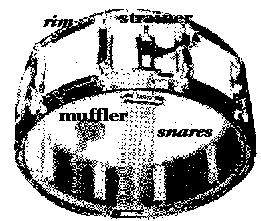
![]()
![]()
Plus, you'll receive downloable copies of all these courses that may easily and instantly be burned to one or fifty
CDs. No waiting for the postman to arrive. Simply do the downloads, then study at your own pace
without being online.
![]()
![]()
![]() Improving Snare Tone
Improving Snare Tone![]()
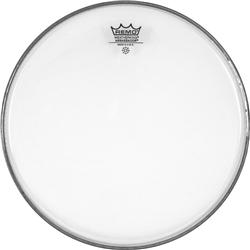
![]() Remo 'Weather King' Ambassador Coated Snare head
Remo 'Weather King' Ambassador Coated Snare head
![]()
![]()
![]() Tuning the Toms
Tuning the Toms Now that you have your snare drum tuned to perfection, we will tune the remainder of the set.
Begin with the smallest tom . . . It will often be situated directly next to and a little above or even
flush with the Snare. This should be your highest pitched tom since it is the smallest. The larger toms
should be graduated in both tone and size in clockwise fashion, around you. When tuning your toms,
try first to imagine all the tones you want. Then seek to achieve those tones. Remember that tight heads
produce higher tones and loose heads produce lower ones. You may wish to experiment with combinations
of tight top heads, loose bottoms for one effect or vice versa for the opposite. Some drummers choose to
eliminate the bottom tom heads completely. Search for the sound that you like. Drum mufflers will help eliminate
any undesirable ‘ring' or 'overtones' in your toms.
![]()
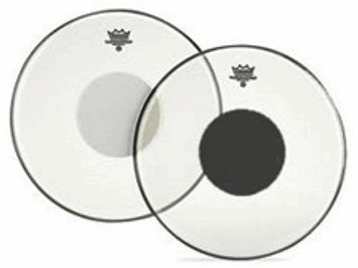
![]()
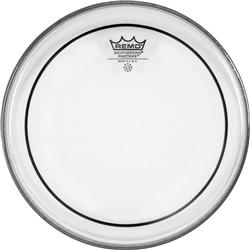
![]()
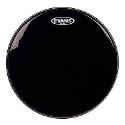
BASS DRUM
If you like your bass drum loud and ringing, that is easy! Simply tighten both heads down and do not try to muffle them. Most drummers
prefer a solid "thud" or "poof" sound.
Place a small patch of duct tape at the point where the Bass Drum Beater-Ball makes contact with the bass drum head. This
will have little effect on the tone but it will inhibit wear on the head, prolong its life and save money.
Brand-name Mylar (plastic) drum heads rarely lose their tone.
However; tonal losses may occasionally occur as a result of lug-screws vibrating loose. A lock-washer
should be in place between the screw and where it makes contact with the rim of the drum. The lock-washers will
prevent the lug-screws from vibrating and backing-out of their position, loosening the tension on the drum heads.
WARNING FOR NEWBIES: It's easy to spot a 'green' drummer onstage. The less experienced drummer will constantly try to tune and re-tune
their drum set in the middle of their gigs. If you are one of those you should understand the following reasoning . . .
Take your snare drum to the garage, the bathroom or any room with a lot of hard surfaces like concrete floors and cinder-block walls.
Listen to the tones! Next, take the drum (as it is) into the living room or a room with an abundance of absorbent materials like,
curtains, carpets, soft easy-chairs and couches. Strike the drum in those new surroundings. Notice the tonal differences! Next, take the drum
outside and strike it again in the out-door environment. Notice the tonal differences there as well. The locational changes will
have a great effect on
the tones, though we've done nothing to the drum itself. We must accept this as a difficult to remedy fact.
![]()
![]()
![]() Working With Music is Important!
Working With Music is Important!It is my hope that by the time you have reached this point in your study. The thrill of playing to music (CDs, records, tapes, radio, etc.)
has become your favorite pastime. If it is not, then something needs to be corrected before you go any further. There
will be little need to study and perfect any of the beats, rolls and fills in the coming lessons if you are not going to
adapt them to music.
![]() Try Working with Headphones
Try Working with Headphones Working with headphones will channel the music more directly to your ears and muffle your own drum sounds too. This will allow
deeper concentration on the music being played. Beware of excessive volume! You can ruin your hearing for life.
RUDIMENTS, ROLLS and FILLS (Part 1): Boring rolls are not so boring when used as thundering fill
patterns in mid-song. (Simplified for beginners!) Back to Lesson Menu #1:

I can I can tune you into a complete MONEY MAKING drumming career within 6 months. Don't
overlook this link! If you snooze, you lose!
![]() Copyright Bill Powelson 1994-2008-2014 @ all rights reserved.
Copyright Bill Powelson 1994-2008-2014 @ all rights reserved.
![]()
![]()
Cool Drum Solos.
Video Drum Solo Lessons Free

Drum Solo Video: Click to 'LEARN' Watch and Learn Now! PLAY Great Drum Solos within hours (not years).
NEW 'Subliminal Method' teaches drum solo techniques PAINLESSLY!
Master rudiments 'NATURALLY' without boring regimentation or serious discipline.
Listen, watch and PLAY your way to awesome drum solos (and polished rudiments) BY SIMPLY HAVING FUN. . . . It works, folks!
Don't be a skeptic until you at least try it first. You owe it to yourself toTRY IT RIGHT NOW!
![]()
![]()
Membership Includes
EVERYTHING FREE! All the E-book icons are "hot" here at the password site. Click an e-book icon and go directly to the product.
Bill Powelson's Other Drumming Courses
![]()
